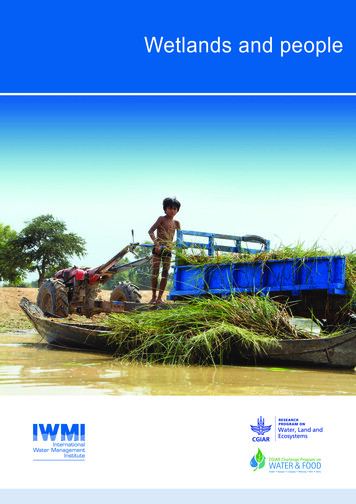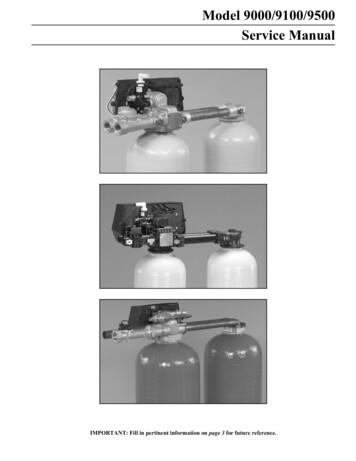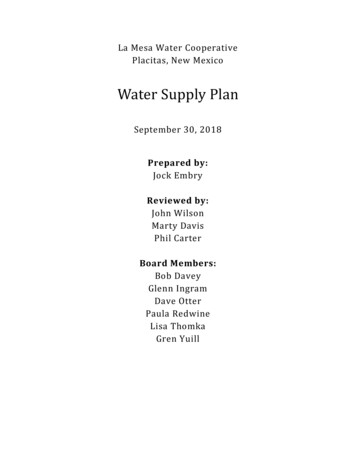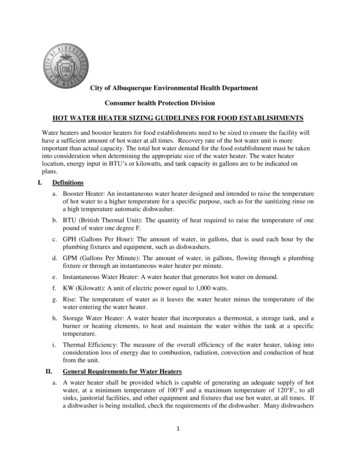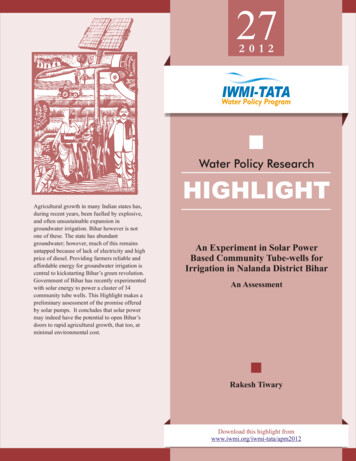
Transcription
272012Water Policy ResearchHIGHLIGHTAgricultural growth in many Indian states has,during recent years, been fuelled by explosive,and often unsustainable expansion ingroundwater irrigation. Bihar however is notone of these. The state has abundantgroundwater; however, much of this remainsuntapped because of lack of electricity and highprice of diesel. Providing farmers reliable andaffordable energy for groundwater irrigation iscentral to kickstarting Bihar’s green revolution.Government of Bihar has recently experimentedwith solar energy to power a cluster of 34community tube wells. This Highlight makes apreliminary assessment of the promise offeredby solar pumps. It concludes that solar powermay indeed have the potential to open Bihar’sdoors to rapid agricultural growth, that too, atminimal environmental cost.An Experiment in Solar PowerBased Community Tube-wells forIrrigation in Nalanda District BiharAn AssessmentRakesh TiwaryDownload this highlight fromwww.iwmi.org/iwmi-tata/apm2012
Water Policy Research Highlight-27AN EXPERIMENT IN SOLAR POWER BASED COMMUNITY TUBE-WELLS FORIRRIGATION IN NALANDA DISTRICT BIHARAN ASSESSMENT1Research highlight based on a paper with the same title2BIHAR'S INITIATIVE ON SOLAR POWER BASEDIRRIGATION:Bihar's agriculture growth has been severely constrainedby irrigation- energy deficits. Despite vast availability ofundeveloped groundwater water resources, irrigationdevelopment in Bihar has been very slow. Energy sectorin the state is facing multiple challenges such as lowgeneration and availability, inadequate infrastructure anddeficient quality of supplies. Consumption of electricity inagricultural activities is extremely low. There is hugedependence on costly diesel based groundwater irrigation.In this scenario, solar power based tube wells can help inplugging the energy deficit and improving farmers' accessto economical and reliable irrigation. Encouraged byavailability of efficient technologies, Bihar governmenthas taken steps to integrate solar energy with agriculturedevelopment plan in the state.Department of Minor Water Resources, Bihar inpartnership with M/s Claro Ventures has launched a keyexperiment in Nalanda district on solar power basedirrigation. Thirty four existing government tube wellswere powered with solar energy in March- April, 2012.The initiative is significant. This is first large scaleexperiment in Eastern India on use of non-conventionalsources of energy for groundwater utilization. For the firsttime in the region, solar energy has been integrated withcommunity managed public tube well irrigation systems.The project thus has shouldered twin challenges: todemonstrate effectiveness of the technology and toshowcase an institutional model of solar power basedirrigation in the state. The experiment has drawn attentionof policy makers and development agencies.realized. Nine solar tube well systems in seven villages ofthe project area were studied. The assessment aimed atgathering experience and feedback from farmers andanalyzing opportunities offered by solar energy basedpumps.Salient features of solar power based energisationprojectThirty four existing tube wells, set up under NationalBank for Agriculture and Rural Development (NABARD)Phase VIII program (2004-2005), were selected forenergization. The tube wells are located in 20 villages offive blocks of Nalanda district. The tube wells have 7.5HP submersible pumps with discharge capacity of 70m3/hour. Solar equipments were installed by ClaroVentures under this solarization project. Threecomponents/features have been added to the existing tubewells: solar panels, variable frequency drive (VFD) and acommunication system.For each tube well, six sets of solar panels have beeninstalled on about 1000 square feet area on the landadjacent to the pump houses; together they generate about600 Volts. The output power from solar panels is fed to theVFD. VFD converts current produced by solar panels tothree phase AC and feeds it to the irrigation pump. Anadvanced communication system is the integral part of thesolar energization project. The system supports real timedata collection, operation modes, and remote monitoring.The solar tube wells of the project have twenty five years'power warrantee; as the implementing agency, ClaroVentures has the responsibility of operations andmanagement of the solar energy related installations forfive years.The Highlight discusses key physical and financialaspects of the project and irrigation benefits being1This IWMI-Tata Highlight is based on research carried out under the IWMI-Tata Program (ITP). It is not externally peer-reviewed and the viewsexpressed are of the author/s alone and not of ITP or its funding partners - IWMI, Colombo and Sir Ratan Tata Trust (SRTT), Mumbai.22This paper is available on request from p.reghu@cgiar.org
SolarCapital cost of pumpand energy sourcehighElectricDieselmodestlowSocial cost ofNilconnecting to grid powerhighnilCost of energy to thefarmernillowhighCost of energy to thesocietynilhighhighCarbon footprintnilhighhigh(winter) and garma (summer) period. The solar energybased irrigation has been integrated with infrastructureand institutions of existing tube wells. Infrastructureincludes a submersible pump, a pump house and waterdistribution network (underground pipelines and outlets).Beyond outlets farmers are expected to carry waterthrough plastic pipes. Water Users Committees areexpected to manage the irrigation, collect fee andmaintain the infrastructure. A Secretary and an Operatorattached to each tube well manage the day to day affairsof irrigation.Experience so farTable 1 compares solar, electric and diesel energy forirrigation pump operation for key factors that affect theirprivate and social economic benefits. Diesel pumps arecheap to buy but expensive to maintain and costly to runwhat with diesel prices soaring by the year. Electricpumps too are inexpensive to buy and maintain; andfarmers find subsidized electricity attractive when it isavailable. But the real cost to serve electricity to a tubewell are upwards of Rs.5/kWh. Moreover, in a state likeBihar with low power network development in ruralareas, the social cost of connecting a tube well to powergrid is high. To top it all, diesel as well as electric pumpsleave a large carbon footprint. Solar pumps are free of allthese pitfalls. They eliminate the cost of connecting tubewells to power grid and provide energy for pumping atnear-zero private and social cost. They also have nocarbon footprint. Electric and diesel pumps fare worse onall these counts. The only downside of solar pumps istheir high capital cost; Claro solar pumps entail a totalcapital investment of Rs.10 lakh3/unit. But these have aneconomic life of 25 years. Thus solar pumps are costefficient in long term in financial terms for farmers.However, if their low carbon footprint is factored in, theycan be cost efficient in economic terms even in the shortto medium terms. As photo voltaic (PV) cell costs keepfalling, solar pumps will keep getting even more attractiveas alternative to electric and diesel pumps. Whereelectricity supply is poor and low, solar pumps providefarmers much-needed independence from grid electricity;and compared to noisy diesel engines, solar pumpspresent hardly any noise pollution. All these togethermake solar pumping a clear winner.Solar energy based IrrigationThirty four solar pumps would provide irrigation in allthree cropping seasons of a year: kharif (monsoon), rabiSolar energy related installations were carried out at alllocations in March, 2012. Panel and VFD integrated wellwith the existing submersible pumps and solar energybased irrigation started in April, 2012. These pumpsprovide water between 8.30 AM to 4.30 PM in general.Farmers have experience of irrigation in two seasons –garma and kharif; rabi irrigation is still awaited.Water Policy Research Highlight-27Table 1 Relative Economics of solar energy, electricity anddiesel for tubewell operation(I) Garma or Summer Crop- Traditionally, garma cropis taken over small proportion of cultivated land due toconstrains of assured and economical irrigation. Maize,pulses, fodder and some vegetables are major garmacrops in this region. There was huge demand for waterfrom solar pumps in the command area during garmaperiod. Farmers received irrigation in 5-8 acres area forcrops like maize, moong, ladyfinger and others.Beneficiaries shared that in garma season, a solar powerbased tube well (7.5 HP) can support irrigation in up to 10acres of cropped area. Thus solar pumps provideopportunities for increasing cultivation and cropdiversification in garma period.During garma period, the sky was mostly clear and amplesun shine was available for long hours during day time.Reportedly, tube wells could be switched on as early as7.30 am/8.00 am in morning and they functionedefficiently till 5 to 5.30 pm. Optimum discharge wasavailable for good 8-9 hours without much daily variation.Log books maintained by operators show that on manydays pumps functioned for 9 hours and even clocked 10hours on some days.(II) Kharif – Rice is major kharif crop in the region. Incurrent season, solar pumps are being used for irrigatingrice crop in area of about 5-10 acres. Encouraged by theexperience in the garma season, farmers in the commandarea were prepared to use solar pumps for paddycultivation. Beneficiaries at all sites specially mentionedcritical support provided by solar pumps in preparation of3One lakh 0.1 million3
Water Policy Research Highlight-27nursery for rice crop. Solar pump helped in providingtimely and adequate number of irrigation for paddy.Beneficiaries expect this would help in improving theyield. Farmers, based on their experience so far, sharedthat solar pumps can definitely support paddy in 15-20acres land.Patterns of functioning of pumps in kharif season: Ondays with clear sky, solar pumps functioned efficientlybetween 8.30/ 9.00 am to 4.30 pm. Pumps provided goodyield of water during 9 am to 3.30 pm; irrigation wasavailable for 6-8 hours in a day. On cloudy days, waterdischarge showed intra-day variation during 8.30 am to3.30 pm during kharif season. Brief cloud intervals haveno significant effect on yield. Farmers shared that after theonset of monsoon (period between July to October) severeovercast conditions and rains interrupted tube wellfunctioning for about 15 days (total). During rainfallspells in kharif season, pumps were switched off. Aftereach rainfall spell there was adequate moisture availablein the fields; usually no irrigation was required forfollowing four- eight days.(III) Rabi - First rabi irrigation is yet to take place butfarmers are upbeat about the utility of solar pumps in rabicultivation particularly for wheat crop. This year farmersexpect that one solar tube well would support 10-12 acresof land under wheat crop. However, some farmers evenreported that the area benefited can be increased to 15acres of land with intensive management and with properdistribution infrastructure, the irrigated area can be raisedto even 20 acres. In wheat cultivation, there is pressure tomeet demands during peak irrigation requirements;farmers believe that solar irrigation would ease thesituation.Irrigation by Solar Power based Tube Wells (7.5 HPCapacity)CroppingSeasonsIrrigated area incurrent year (byone solar poweredtube well)Potential area (byone solar poweredtube well)Garma5-8 acres10 acresKharif5-10 acres15-20 acresRabi5-12 acres(expected in 201213 Rabi)15-20 acresFarmers, at all sites, expressed great satisfaction fromfunctioning of solar pumps. They shared that pumps yieldwater on regular basis for long hours. They consider it areliable and economical source of irrigation. In plots thatbenefitted from solar pumps, beneficiaries were savedfrom costly irrigation based on diesel fuel. Majority offarmers in the region depend on diesel pumps (5 HPpumps, 5 HP and 3 HP). Price of diesel is increasing onregular basis. Diesel based irrigation from water markethas gone up to Rs.75- 90 per hour. There are alsoproblems, reportedly, relating to adulteration of fuel andcheating by the pump owners in measurements.Tube well irrigation based on electric power is available infew villages of the region; facility of three phase electricpower is awaited in large part of rural areas. In somevillages electric tube wells are working but power isavailable only for 4-5 hours per day. There is no fixedschedule; farmers keep waiting during interruptions andon many occasions they have to irrigate fields in night.Functioning of Solar Power based Tube wellsCroppingSeasonsGarmaKharifRabi4Time ofstart ofpumpTime ofswitchingoffAverageInterruptionshours offunctioning7.30/8.00 am5.00/5.30 pm8-9 hours8.30/9.00 am4.00/4.30 am6-8 hoursawaitedawaitedawaitedWater Rates in VillagesOptions of EnergySourcesNilSevereovercastconditionsand rainydaysExpectedlyduring intensefog periodsPrevalent RatesSolarRs.3 -5 per katha and upto Rs.10 per katha( one acre 32 katha)ElectricRs.10 per kathaDiesel pumpsRs.75-90 per hour
Water Policy Research Highlight-27Economical Irrigation from solar pumpsMaintenance of InstallationsWater Users Committees attached to community tubewells with solar pumps are expected to manage theirrigation and collect fee from beneficiaries. The rates ofirrigation are very nominal. The irrigation rates varybetween, Rs.55 to Rs.75 per acre according to the seasonand the number of irrigations applied.Claro Ventures has the responsibility of operation andmanagement of solar energy related installations for firstfive years. In almost all cases, solar pumps have beenfunctioning without any interruptions and problems.Minor problems emerge in wire connections likebreakage, need of protective cover. In case of anyproblem, operators are expected to call local office (in thedistrict headquarter) for help. Presence of a local officewith competent technical staff has helped in extendingquick response and solutions. In almost cases, timely andsatisfactory maintenance service was reported. There havebeen four instances of theft of portions of panels. Thepanels were replaced within 5-6 days. Claro Ventures'central office monitors the operations; Operators also getinstructions from central office based on data received formonitoring systems.Beneficiaries mainly belong to small and marginal farmercategory. Operators have calculated irrigation rates interms of rupees per katha. Our study revealed that rates ofirrigation being collected from solar pumps currently vary.Three categories of rates were reported: (i) variable ratesof irrigation i.e Rs.3/katha in garma and Rs.5/katha inkharif; (ii) fixed rate of Rs.5/katha in two seasons and (iii)Rs.10/katha. With more clarity, awareness and experience,greater uniformity in rates is expected.Currently, Operators are maintaining records of irrigationin terms of beneficiaries' name, area of irrigation, durationof irrigation to calculate the dues. Operators are expectedto make entries in the log book on daily basis. In mostcases, operators have updated the records. In the studiedsystems, the tube well functionaries informed that largepart of the irrigation fee has been collected.Operators have received two rounds of training since thesolar pumps started functioning. Functionaries havefound the operations easy and user friendly. There is nodifficulty in handling components of installations andmanaging daily operations.5
Water Policy Research Highlight-27Enhancing benefits with institutional strengtheningand infrastructural improvementSolar energy based irrigation pumps have beenfunctioning efficiently since April 2012. Farmers havedeveloped faith in the technology. Based on experience ingarma and kharif period, they reported that solartechnology would be very helpful for irrigation. Theprogram is in early stage of implementation, it provides anopportunity to identify bottlenecks and ensure betterirrigation to cultivators. Functionaries and farmers sharedfeedback/suggestions for improvement in irrigationservices; measures can be discussed under two sections:institutional strengthening and infrastructuralimprovement.(I) Institutional Strengthening:Various measures will help in improving the institutionalpractices and management of solar energy basedirrigation:(i) Greater awareness among cultivators in the commandarea about benefits of solar energy irrigation, ways toaccess irrigation, and appropriate irrigation schedulingwould help in maximizing the benefits.(ii) Increased awareness and clarity about scheduledirrigation charges/fee among all members of committee,potential beneficiaries, key functionaries of Panchayatand others would help in collection of revenue. Simpledesign of irrigation charges can be communicated easily.(iii) Irrigation rates can be reviewed to supportexpenditures on infrastructure (maintenance,improvement and extension). Performance basedincentives for functionaries can also be considered.(iv) Regular training to Operators/Secretaries andsimplification of data collection processes would help inbetter management of records.(v) Assessment of specific periods of irrigation demand(crop wise) will help in the management of waterallocation. With experience, a framework or rules of waterallocation can be developed.(II) Infrastructure improvement:Infrastructure created during the NABARD program wasrenovated in thirty four solar power based tube wellsystems. Functionaries and farmers shared that furtherimprovements in infrastructure facilities would (i)increase access to irrigation service and coverage of landunder irrigation, (ii) improve water distribution efficiency;and (iii) ensure the safety of installations. Majorsuggestions of functionaries and cultivators are listedbelow.(a) Need of extension of length of underground pipelines(at least by 200 feet) was voiced at all sites4 (b)Replacement of faulty valves; at many locations faultshave rendered specific pipelines non- functional. (c)Underground pipelines must be renovated by replacementof broken sections of PVC pipes; pipes with greater loadbearing capacities should be used for replacement.Another set of suggestions about infrastructuraldevelopment is related to safety of solar installations.Secretary/Operators of Water Users Committees sharedthat the protection of solar panels is a major concern. TheDepartment has made provisions for insurance of panels.To protect the structures from theft and damage,functionaries have asked for fencing of the area aroundpanels. Operators expressed concern over security ofassets; they can be damaged or stolen. For better visibilityand protection during the night, operator-cum-guards havemade request for provision of light in the tube wellpremises.Summary and ConclusionInstallation of solar energy based irrigation pumps is animportant initiative taken by Department of Minor WaterResources, Bihar and Claro Ventures. Two conventionalsources of energy for tube well irrigation have poseddifferent set of difficulties for farmers. Electric tube wellsare few and they are afflicted with inadequate & irregularpower supplies. Cultivators in the region are primarilydependent on costly diesel based irrigation. In this contextsolar pumps have offered economical and reliableirrigation to cultivators in the command area of thirty fourtube wells.The solar power based technology has integrated quitewell with existing community tube well systems; groundwater pumping is being efficiently executed. Advancedfeatures (panels, VFD, solar tracking and others) are alsoworking efficiently. Solar pumps are working on anaverage for 6-7 hours a day.Based on experience with garma and kharif season,farmers consider the solar power based irrigation aseffective and extremely useful technology. Farmers have4Currently, cultivated land beyond outlets can receive irrigation by attaching plastic pipes of different lengths. Farmers manage pipes (selfand/or shared). There are instances when water is being carried up to 1000-1500 feet.6
There is a scope to enhance irrigation benefits andcoverage area with improvements in institutional practicesand infrastructure. Awareness about the irrigation facilitiesfrom solar energy and irrigation charges, simplificationand compliance of rules, provision of incentives forfunctionaries and their capacity building and improvementin water distribution infrastructure would help inenhancing service delivery and access of irrigation. Stepsshould be taken to make tube wells systems more efficientand self sustaining by bringing necessary modifications inthe institutional design. The learning from thirty four tubewell systems will be very helpful in solarization ofirrigation pumps in other parts of Bihar.The Nalanda experiment demonstrater the effectiveness ofthe solar technology and it has presented an institutionalmodel for growth of solar pumps. The initiative alsoshowcases immense possibilities that solar power basedtube wells offer. Solar pumps can significantly contributein reducing irrigation- energy deficits and ensuringgroundwater based agriculture growth in Bihar. Theopportunity must be seized by developing right strategiesand policy framework for expansion of solar power basedirrigation.Water Policy Research Highlight-27found the technology particularly useful for garma cropsand paddy cultivation. Solar pumps were used forirrigation in 5-8 acres in garma period and 5-10 acres inkharif period; rise in coverage is expected in comingyears. Beneficiaries of solar pumps expressed relief fromdependence on costly diesel pump based irrigation. Theylook forward to using solar pumps for economical andadequate irrigation for wheat crop in rabi season. Initialexperience show that solar power based irrigation iseffective for irrigation in different seasons; it can help inincreasing the total cultivated area and cropdiversification.7
About the IWMI-Tata Program and Water Policy HighlightsThe IWMI-Tata Water Policy Program (ITP) was launched in 2000 as a co-equalpartnership between the International Water Management Institute (IWMI), Colombo andSir Ratan Tata Trust (SRTT), Mumbai. The program presents new perspectives andpractical solutions derived from the wealth of research done in India on water resourcemanagement. Its objective is to help policy makers at the central, state and local levelsaddress their water challenges – in areas such as sustainable groundwater management,water scarcity, and rural poverty – by translating research findings into practical policyrecommendations. Through this program, IWMI collaborates with a range of partnersacross India to identify, analyze and document relevant water-management approachesand current practices. These practices are assessed and synthesized for maximum policyimpact in the series on Water Policy Highlights and IWMI-Tata Comments.Water Policy Highlights are pre-publication discussion papers developed primarily as thebasis for discussion during ITP's Annual Partners' Meet. The research underlying theseHighlights was funded with support from IWMI, Colombo and SRTT, Mumbai.However, the Highlights are not externally peer-reviewed and the views expressed are ofthe author/s alone and not of ITP or either of its funding partners.IWMI OFFICESIWMI Headquarters and Regional Office for Asia127 Sunil Mawatha, PelawatteBattaramulla, Sri LankaTel: 94 11 2880000, 2784080Fax: 94 11 2786854Email: iwmi@cgiar.orgWebsite: www.iwmi.orgIWMI OfficesSOUTH ASIAHyderabad Office, IndiaC/o International Crops Research Institute for the SemiArid Tropics (ICRISAT)401/5, Patancheru 502324, Andhra Pradesh, IndiaTel: 91 40 30713735/36/39Fax: 91 40 30713074/30713075Email: p.amerasinghe@cgiar.orgNew Delhi Office, India2nd Floor, CG Block C, NASC ComplexDPS Marg, Pusa, New Delhi 110 012, IndiaTel: 91 11 25840811/2, 65976151Fax: 91 11 25842075Email: iwmi-delhi@cgiar.orgLahore Office, Pakistan12KM Multan Road, Chowk Thokar Niaz BaigLahore 53700, PakistanTel: 92 42 35299504-6Fax: 92 42 35299508Email: iwmi-pak@cgiar.orgIWMI-Tata Water Policy Programc/o INREM FoundationNear Smruti Apartment, Behind IRMAMangalpura, Anand 388001, Gujarat, IndiaTel/Fax: 91 2692 263816/817Email: iwmi-tata@cgiar.orgSOUTHEAST ASIASoutheast Asia OfficeC/o National Agriculture and Forestry ResearchInstitute (NAFRI)Ban Nongviengkham,Xaythany District,Vientiane, Lao PDRTel: 856 21 740928/771520/771438/740632-33Fax: 856 21 770076Email: m.mccartney@cgiar.orgCENTRAL ASIACentral Asia OfficeC/o PFU CGIAR/ICARDA-CACApartment No. 123, Building No. 6, Osiyo StreetTashkent 100000, UzbekistanTel: 998 71 237 04 45Fax: 998 71 237 03 17Email: m.junna@cgiar.orgAFRICARegional Office for Africa and West Africa OfficeC/o CSIR Campus, Martin Odei Block,Airport Residential Area(Opposite Chinese Embassy), Accra, GhanaTel: 233 302 784753/4Fax: 233 302 784752Email: iwmi-ghana@cgiar.orgEast Africa & Nile Basin OfficeC/o ILRI-Ethiopia CampusBole Sub City, Kebele 12/13Addis Ababa, EthiopiaTel: 251 11 6457222/3 or 6172000Fax: 251 11 6464645Email: iwmi-ethiopia@cgiar.orgSouthern Africa Office141 Cresswell Street, Weavind ParkPretoria, South AfricaTel: 27 12 845 9100Fax: 27 86 512 4563Email: iwmi-southern africa@cgiar.orgIWMI SATELLITE OFFICESKathmandu Office, NepalJhamsikhel 3, Lalitpur, NepalTel: 977-1-5542306/5535252Fax: 977 1 5535743Email: l.bharati@cgiar.orgOuagadougou Office, Burkina FasoS/c Université de Ouagadougou Foundation2iE 01 BP 594 Ouagadougou, Burkina FasoTel: 226 50 492 800Email: b.barry@cgiar.org
yield of water during 9 am to 3.30 pm; irrigation was available for 6-8 hours in a day. On cloudy days, water discharge showed intra-day variation during 8.30 am to 3.30 pm during kharif season. Brief cloud intervals have no significant effect on yield. Farmers shared that after the onset of monsoon (period between July to October) severe



